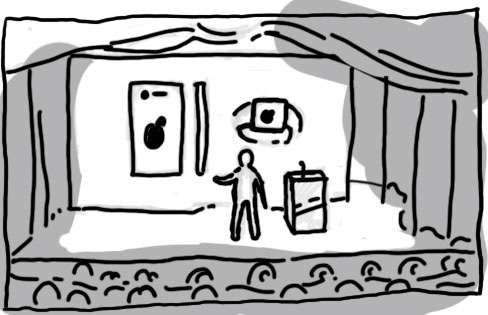The Mother of all Demos!
San Francisco, a 20-year-old boy, a radar technician, was on board a navy ship. People were waving goodbyes to their loved ones!
Just as the ship was leaving the shore, the public announcement system relayed a message: ‘The Japanese have surrendered! The War Ends!’ The year was 1945.
As soon as the announcement was made, everyone onboard shouted, "Turn around! Let us go back and celebrate!” But the ship kept sailing, right out into the fog, into the seasickness, and onto Leyte Gulf in the Philippines.
The assignment for which they had set sail had to be pursued, so off they went! But, since there was no war anymore, the crew on board the ship had some free time on their hands.
One day, the young lad, aka our protagonist, came across a hut built on stilts with animals living underneath.
Determined to see what the place was, he climbed up a small ladder leading up to the hut and was more than pleasantly surprised. It was a cozy little place with books all over and the best part? There was no one else around! A sign hung outside the hut and read Red Cross Reading Library.
It was quite the discovery for him, and the place would later become a refuge of sorts. And thank heavens it happened because as fate would have it, if we were to call it that, something extraordinary was to happen. Dear reader, in that library on the edge of that jungle on an island in the Philippines, this young boy would lay his eyes on a piece of writing that would not only profoundly shape the contours of his future but all of ours!
That young boy was Douglas Engelbart, and the text he came across was an essay titled ‘As We May Think’ by Vannever Bush, an engineer extraordinaire. In the essay, published in 1945, Mr. Bush, would with bewildering accuracy, anticipate many aspects of the modern world we live in and take for granted today.
Seventeen more years would pass since the ‘incident’ on the island, and in 1962, Engelbart (in his late 30s), while working in academia, would go on to publish a manifesto titled ‘Augmenting Human Intellect’: 45,000 words in which he explained to the world what he was up to. He envisioned a future where he wanted to combine the processing prowess of a machine with the intuitive talents of the human mind. He wanted computers of the future to solve not just math or science specific problems but rather emphasized ‘Every person who does his thinking with symbolized concepts (whether in the form of the English language, pictographs or formal logic) should be able to benefit significantly from these machines in the future’. Six years later, he would proceed to demonstrate to the world exactly how!
Today, we are all quite familiar with tech demonstrations. Steve Jobs was iconic and known for them; Elon Musk's name comes to mind; but there are hundreds and thousands of these demos which take place every year. Agreed, some are fancier than the others, but what was about to take place on that fateful rainy Monday on the 9th of Dec, 1968, at the civic auditorium in San Francisco would go down in history as the mother of ALL DEMOS and it came from someone who was apparently monotonous and painfully shy.
‘Alan Kay, [one of the pioneers of object-oriented programming and windows graphical user interface] struggled to make sure that he got to Engelbart’s Mother of All Demos. He had a 102-degree fever and strep throat, but he was able to drag himself onto a plane from Utah, where he was a graduate student. “I was shivering and sick and could barely walk,” he recalled, “but I was determined to get there.”44 He had already seen and embraced Engelbart’s ideas, but the drama of the demonstration struck him like a clarion call. “To me he was Moses opening the Red Sea,” Kay said. “He showed us a promised land that needed to be found, and the seas and rivers we needed to cross to get there.”’1
Thanks to Engelbart, in a 90 minute near-flawless demonstration, the world, for the first time would witness a modern desktop-style user interface, a computer mouse, word processing, hyper-text, video conferencing, a collaborative real time editor among many others. Just a little reminder, the year was 1968!
“Engelbart foreshadowed just about everything Apple and Microsoft went on to create—at a time when Jobs and Bill Gates were just 13 years old. He made Alan Kay ponder, “I don’t know what Silicon Valley will do when it runs out of Doug’s ideas.”2
Here's a glimpse from the demo. Enjoy! :)










